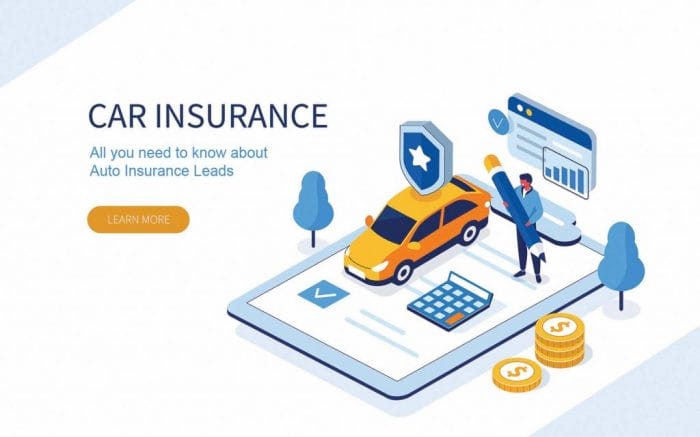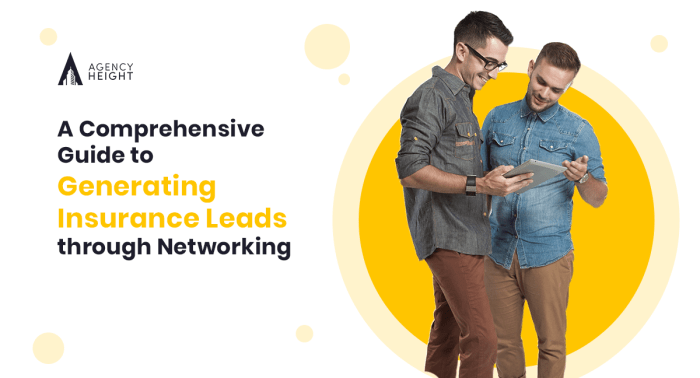In the competitive realm of auto insurance, generating leads is akin to finding a treasure trove of potential customers. It’s a skill that requires a blend of strategic planning, creative marketing, and exceptional customer service. Join us as we embark on a journey to uncover the secrets of lead generation in the auto insurance industry, exploring proven techniques to attract and convert prospects into loyal policyholders.
From understanding the nuances of auto insurance coverage to leveraging the power of digital marketing, we’ll delve into the intricacies of lead generation. Whether you’re an insurance professional seeking to expand your clientele or a business owner looking to boost your auto insurance sales, this comprehensive guide will equip you with the knowledge and strategies to excel in this dynamic field.
Insurance Coverage

Understanding auto insurance coverage is essential for protecting yourself financially in the event of an accident. Different types of coverage provide varying levels of protection, and choosing the right ones is crucial. This guide explains the importance of understanding coverage options and provides tips for selecting the appropriate levels based on individual needs and budget.
Liability Coverage
Liability coverage protects you against financial responsibility for damages or injuries caused to others in an accident. It covers expenses like medical bills, property damage, and legal fees. State laws determine minimum liability coverage requirements, but it’s advisable to purchase higher limits for more comprehensive protection.
Collision Coverage
Collision coverage reimburses you for damages to your own vehicle resulting from a collision with another vehicle or object. It’s optional in most states but highly recommended, especially if you have a newer or expensive vehicle. The coverage amount is typically the actual cash value of your car at the time of the accident.
Comprehensive Coverage
Comprehensive coverage protects your vehicle against damages caused by non-collision events like theft, vandalism, fire, natural disasters, and animal collisions. It’s optional but recommended for comprehensive protection. The coverage amount is typically the actual cash value of your car at the time of the loss.
Uninsured/Underinsured Motorist Coverage
Uninsured/underinsured motorist coverage protects you in case of an accident caused by a driver without insurance or with insufficient coverage. It covers medical expenses, lost wages, and property damage. This coverage is optional but highly recommended, given the prevalence of uninsured drivers on the road.
Choosing the Right Coverage Levels
When selecting coverage levels, consider the following factors:
- State Requirements: Review your state’s minimum coverage requirements and consider purchasing higher limits for more comprehensive protection.
- Vehicle Value: Determine the actual cash value of your vehicle to ensure adequate coverage in case of a total loss.
- Driving Habits: Assess your driving habits and risk tolerance. If you commute long distances or frequently drive in high-risk areas, consider higher coverage limits.
- Financial Situation: Evaluate your financial situation and determine how much you can afford to pay for insurance premiums. Choose coverage levels that provide adequate protection without straining your budget.
Discounts and Savings

Discounts and savings opportunities are key to finding the most affordable auto insurance rates. There are various ways to save money on your policy, including bundling policies, maintaining a clean driving record, taking advantage of loyalty programs, and negotiating with insurance providers.
Bundling Policies
- Bundling your auto insurance policy with other types of insurance, such as home or renters insurance, can often lead to significant savings.
- Insurance companies offer discounts to customers who bundle their policies because it reduces their administrative costs and increases customer retention.
Maintaining a Clean Driving Record
- Maintaining a clean driving record is one of the best ways to save money on auto insurance.
- Drivers with clean records are considered less risky to insure, so they are offered lower rates.
- Traffic violations and accidents can lead to higher insurance rates, so it is important to drive safely and obey the traffic laws.
Taking Advantage of Loyalty Programs
- Many insurance companies offer loyalty programs that reward customers for staying with them for a certain period of time.
- These programs can provide discounts on premiums, as well as other benefits, such as free roadside assistance or accident forgiveness.
- Check with your insurance company to see if they offer a loyalty program.
Negotiating with Insurance Providers
- Don’t be afraid to negotiate with your insurance provider to get the best rate possible.
- Insurance companies are often willing to offer discounts to customers who ask for them.
- You can also shop around for quotes from different insurance companies to see if you can find a better deal.
Customer Service and Claims Handling
Selecting an insurance provider with exceptional customer service and a seamless claims handling process is crucial. It ensures prompt assistance, efficient resolution, and overall satisfaction during your time of need.
Evaluating the reputation and track record of insurance companies is essential. Consider factors like customer satisfaction ratings, claims resolution efficiency, and industry recognition. Positive feedback from existing customers and a history of prompt claims settlements indicate a provider’s commitment to customer-centric service.
Transparency and Communication
Transparency and effective communication are key. Look for providers who provide clear and comprehensive policy information, making it easy to understand your coverage and terms. Regular communication, such as policy updates and claim status notifications, demonstrates a provider’s dedication to keeping you informed.
24/7 Availability and Multiple Contact Channels
24/7 availability and multiple contact channels ensure you can reach your insurance provider whenever you need them. Whether it’s through phone, email, online chat, or mobile app, having various communication options provides convenience and peace of mind.
Claims Handling Efficiency
A streamlined claims handling process is essential. Look for providers known for prompt claims processing, fair claim settlements, and a hassle-free experience. Consider their online claims submission options, the expertise of their claims adjusters, and the overall efficiency of their claims department.
Customer Testimonials and Reviews
Customer testimonials and reviews offer valuable insights into the actual experiences of policyholders. Read online reviews, ask for recommendations from friends or family, and engage with the provider’s social media platforms to gather feedback from existing customers.
Online Presence and Digital Marketing

In the modern digital landscape, maintaining a strong online presence is essential for insurance agencies seeking to attract new customers and generate leads. This involves creating a user-friendly website that is optimized for search engines and engaging with potential customers through social media and content marketing strategies.
Effective Website Design
A well-designed website serves as the cornerstone of your online presence. It should be visually appealing, easy to navigate, and optimized for search engines through techniques like research and search engine optimization (). By ensuring your website ranks higher in search results, you increase its visibility and attract more potential customers.
Engaging Social Media Presence
Social media platforms offer a powerful channel for insurance agencies to connect with potential customers, share valuable content, and generate leads. By creating engaging social media posts, running targeted ads, and interacting with followers, agencies can build brand awareness, establish thought leadership, and drive traffic to their website.
Content Marketing Strategies
Content marketing is an effective way to attract and engage potential customers by providing valuable information and insights. This can include blog posts, articles, videos, infographics, and other forms of content that address common insurance-related questions and concerns. By consistently publishing high-quality content, agencies can establish themselves as trusted resources and generate leads through organic search traffic and social media shares.
Partnerships and Referrals

Building strategic partnerships and referral programs can significantly expand your customer base and drive lead generation.
Developing Strategic Partnerships
Forming alliances with local businesses that complement your insurance offerings can yield mutually beneficial outcomes. Collaborate with car dealerships, repair shops, financial institutions, and other relevant businesses to cross-promote products and services, share leads, and increase brand visibility.
These partnerships can take various forms. For instance, you could offer exclusive discounts or incentives to customers referred by your partners, or co-host events and workshops to attract a wider audience.
Referral Programs
Encouraging existing customers to refer new customers through referral programs is a cost-effective way to generate leads and grow your business. Offer incentives such as discounts, gift cards, or loyalty rewards to customers who successfully refer new clients to your insurance agency.
To maximize the impact of your referral program, make it easy for customers to participate. Provide clear instructions, referral forms, and trackable links that they can easily share with their friends, family, and colleagues.
Community Involvement and Events

Engaging in community activities and events is a powerful strategy to enhance brand recognition, establish meaningful connections, and generate leads for your auto insurance business.
By actively participating in local initiatives, sponsoring events, and supporting charitable causes, you can effectively position your company as a responsible and caring entity that values community well-being.
Organizing Educational Seminars and Workshops
Hosting educational seminars and workshops related to auto insurance and road safety is a proactive approach to attracting potential customers and demonstrating your expertise in the field.
These events provide an excellent platform to engage with your target audience, educate them about essential insurance coverage, safe driving practices, and industry trends, and establish yourself as a trusted advisor.
Lead Capture and Nurturing

In today’s digital age, generating leads online is essential for auto insurance providers. To effectively capture and nurture leads, insurance companies should focus on creating user-friendly lead capture forms, implementing lead nurturing campaigns, and providing personalized experiences.
Lead capture forms should be designed to collect essential contact information from potential customers, such as name, email address, phone number, and vehicle information. Landing pages should be optimized for conversions, with clear calls to action and concise explanations of the benefits of the insurance product.
Lead Nurturing Campaigns
Lead nurturing campaigns are crucial for converting leads into paying customers. These campaigns involve sending personalized emails, targeted content, and special offers to potential customers over time. The goal is to educate leads about the insurance product, build trust, and encourage them to take the next step, such as requesting a quote or scheduling an appointment.
Data Analysis and Market Research

Harnessing the power of data analytics and market research is crucial for identifying growth opportunities, enhancing customer satisfaction, and staying competitive in the insurance industry. By delving into customer data and market trends, insurance companies can uncover valuable insights that inform strategic decisions, improve marketing and sales strategies, and deliver personalized products and services.
Customer Data Analysis
Analyzing customer data provides a wealth of information about policyholder behavior, preferences, and pain points. This data can be leveraged to:
- Identify profitable customer segments and target marketing efforts accordingly.
- Develop tailored products and services that address specific customer needs.
- Enhance customer retention by identifying and addressing potential churn factors.
- Personalize marketing messages and offers to increase engagement and conversion rates.
Market Research
Conducting thorough market research is essential for understanding the competitive landscape, emerging trends, and customer needs. Market research can help insurance companies:
- Identify new market opportunities and expand into untapped markets.
- Stay abreast of industry trends and innovations to maintain a competitive edge.
- Gain insights into customer preferences, pain points, and decision-making processes.
- Develop marketing and sales strategies that resonate with the target audience.
Employee Training and Development
In today’s dynamic insurance landscape, providing comprehensive training and development programs for sales agents and customer service representatives is crucial for maintaining a competitive edge and delivering exceptional customer service. These programs should focus on enhancing employees’ knowledge, skills, and professionalism to drive business growth and customer satisfaction.
By fostering a culture of continuous learning and improvement, insurance companies can ensure that their employees stay updated with industry trends, regulatory changes, and best practices. This ongoing commitment to professional development empowers employees to provide expert advice, navigate complex insurance policies, and resolve customer inquiries with confidence and efficiency.
Training Curriculum
Effective training programs should cover a wide range of topics, including:
- Product knowledge: In-depth understanding of insurance products, their features, benefits, and limitations.
- Sales techniques: Effective communication, active listening, objection handling, and closing techniques to drive sales.
- Customer service skills: Building rapport, empathy, and conflict resolution to deliver exceptional customer experiences.
- Regulatory compliance: Knowledge of insurance regulations, legal requirements, and ethical standards to ensure adherence to industry guidelines.
- Technology proficiency: Familiarity with insurance software, digital tools, and online resources to streamline processes and enhance productivity.
Continuous Learning and Development
To stay ahead of the curve, insurance companies should promote a culture of continuous learning and development among their employees. This can be achieved through:
- Regular training sessions: Conduct ongoing training programs to keep employees updated with the latest industry developments, product updates, and regulatory changes.
- Mentorship programs: Pair experienced employees with new hires or less experienced colleagues to provide guidance, support, and knowledge transfer.
- Online resources: Provide access to online courses, webinars, and industry publications to encourage self-directed learning and professional growth.
- Conferences and workshops: Encourage employees to attend industry conferences, workshops, and seminars to network, learn from experts, and stay abreast of emerging trends.
Performance Monitoring and Optimization
Regularly evaluating the effectiveness of lead generation strategies is crucial for optimizing performance and achieving desired outcomes. Implementing a robust monitoring and optimization framework enables insurance companies to track progress, identify areas for improvement, and fine-tune their marketing and sales approaches.
A well-structured performance monitoring system involves establishing key performance indicators (KPIs) that align with specific lead generation and sales goals. These KPIs serve as quantifiable metrics that measure the success of marketing campaigns, sales efforts, and overall lead generation initiatives.
KPIs for Lead Generation
- Website Traffic: Monitoring website traffic, including unique visitors, page views, and bounce rates, provides insights into the effectiveness of online marketing efforts and the overall health of the website.
- Lead Volume: Tracking the number of leads generated through various channels, such as online forms, phone calls, and referrals, helps assess the effectiveness of lead generation strategies and identify high-performing channels.
- Lead Quality: Evaluating the quality of leads, including their relevance to the insurance products and services offered, helps determine the effectiveness of lead qualification processes and ensures that sales teams focus on qualified prospects.
- Conversion Rates: Measuring the percentage of leads who convert into customers provides insights into the effectiveness of sales processes and the overall customer experience.
KPIs for Sales Performance
- Sales Volume: Tracking the number of policies sold or the total revenue generated helps assess the overall performance of the sales team and the effectiveness of sales strategies.
- Average Sales Cycle Length: Monitoring the time it takes from initial lead contact to policy issuance provides insights into the efficiency of sales processes and identifies potential bottlenecks.
- Customer Satisfaction: Evaluating customer satisfaction levels through surveys or feedback mechanisms helps identify areas for improvement in the sales process and ensures that customers have a positive experience.
Optimization Strategies
Based on the analysis of performance data, insurance companies can implement various optimization strategies to improve lead generation and sales performance.
- Adjusting Marketing Campaigns: Analyzing website traffic and lead volume data helps identify underperforming marketing campaigns and allows for adjustments to improve their effectiveness.
- Improving Lead Qualification: Refining lead qualification processes ensures that sales teams focus on high-quality leads, leading to improved conversion rates and sales performance.
- Optimizing Sales Processes: Evaluating sales cycle length and customer satisfaction levels enables insurance companies to streamline sales processes, reduce bottlenecks, and enhance the customer experience.
- Retargeting Efforts: Utilizing marketing automation tools to retarget leads who have not yet converted can help recapture their attention and nurture them further through personalized messaging.
By continuously monitoring performance and implementing optimization strategies, insurance companies can refine their lead generation and sales processes, improve overall performance, and achieve their business objectives.
Summary

As we conclude our exploration of auto insurance lead generation strategies, it’s evident that success lies in adopting a holistic approach. By combining a deep understanding of customer needs, innovative marketing techniques, and exceptional customer service, insurance professionals can unlock the true potential of lead generation.
Embrace these strategies, adapt them to your unique circumstances, and witness the growth of your auto insurance business soar to new heights.
Questions and Answers
Q: What are some common discounts and savings opportunities available in auto insurance?
A: Bundling policies, maintaining a clean driving record, taking advantage of loyalty programs, and utilizing promotional offers are effective ways to secure discounts and savings on auto insurance premiums.
Q: How can I evaluate the reputation and track record of insurance companies?
A: Customer satisfaction surveys, industry rankings, online reviews, and claims resolution efficiency metrics are valuable resources for assessing the reputation and track record of insurance companies.
Q: What are effective ways to generate leads through partnerships and referrals?
A: Developing strategic partnerships with local businesses, implementing referral programs that incentivize existing customers, and participating in community events and initiatives can yield significant lead generation opportunities.
Q: How can I design effective lead capture forms and landing pages?
A: Keep forms concise, focus on essential information, optimize for mobile devices, and create compelling landing pages that clearly communicate the value proposition of your auto insurance offerings.
Q: What are some best practices for lead nurturing in auto insurance?
A: Implement email marketing campaigns, personalize communications, provide valuable content, and track customer engagement to nurture leads and convert them into paying customers.



